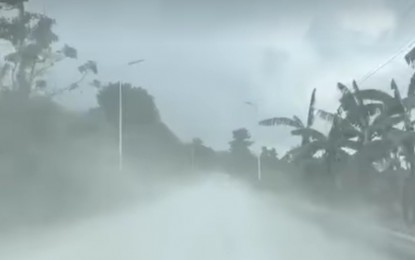
ASHFALL. Heavy ashfall was observed along a road in La Castellana, Negros Occidental, on Tuesday (June 4, 2024) following the explosive eruption of Mt. Kanlaon Monday night (June 3). The Sugar Regulatory Administration initiated the conduct of a sampling on Tuesday to determine the effects of the volcanic eruption on sugar lands and canes in Negros Occidental. (Screenshot from Department of Social Welfare and Development-Western Visayas)
BACOLOD CITY – The Sugar Regulatory Administration (SRA) has allocated PHP2.5 million to assist affected local government units (LGUs) and conducted sampling to determine the effects of the eruption of Mt. Kanlaon Monday night on sugar lands and canes in Negros Occidental.
In a statement on Tuesday, SRA Administrator Pablo Luis Azcona said he ordered the release of PHP2 million for mitigating measures for LGUs and PHP500,000 for medical missions that would address cases of respiratory diseases related to the incident, if needed.
Azcona said he directed the SRA research and development arm to prioritize the sampling.
“We gathered reports from the field of the strong sulfur smell coupled with the heavy rains in most areas in central Negros. We know that this can turn into sulfuric acid, which may affect our sugar canes,” he said.
Azcona said the SRA needs to gather information on the acidity level of the soil, as well as its effects on canes planted in areas affected by volcanic ashfall.
Ash will be scraped from cane leaves and collected from surface grounds, particularly in La Castellana, Moises Padilla, and Pontevedra towns and the City of La Carlota, where sugarcane fields turned gray because of volcanic ash.
Azcona said they received reports that some farmers took advantage of the heavy rains following the eruption to plant canes.
“I asked the research department to immediately release results of the test. We are hoping that the rains washed out the volcanic ash from planted canes,” he added.
The SRA chief said the “general condition of the sugarcane fields is already acidic.”
“We just want to rule out more acidity in affected areas that can cause problems,” he said.
At 6:51 p.m. Monday, Mt. Kanlaon in Negros Island erupted and produced a 5,000-meter plume that brought coarse ashfall and sulfurous odor to the surrounding localities in Negros Occidental.
The Department of Science and Technology-Philippine Institute of Volcanology and Seismology raised the active volcano’s alert level from Alert Level 1 (abnormal) to Alert Level 2 (increasing unrest), which means “there is current unrest driven by shallow magmatic processes that could eventually lead to further explosive eruptions or even precede hazardous magmatic eruption.” (PNA)
